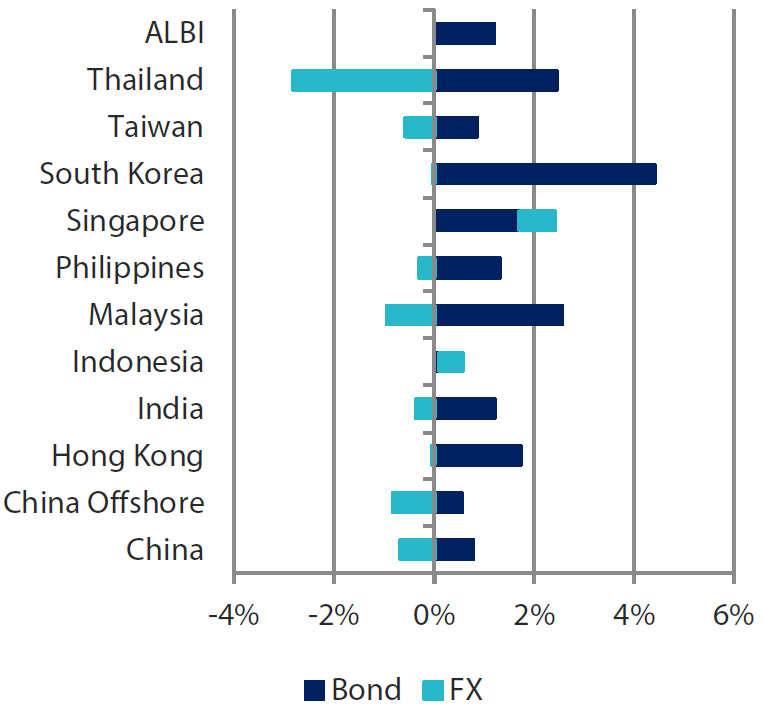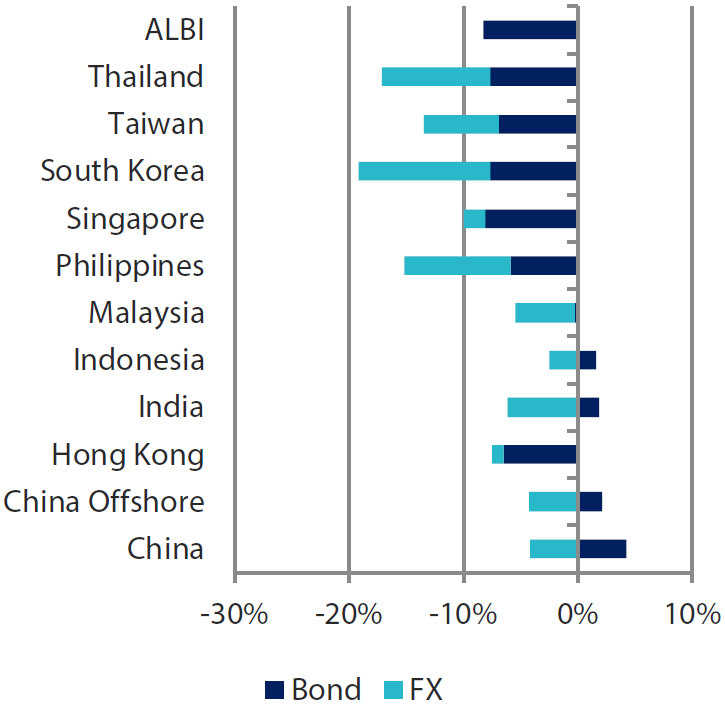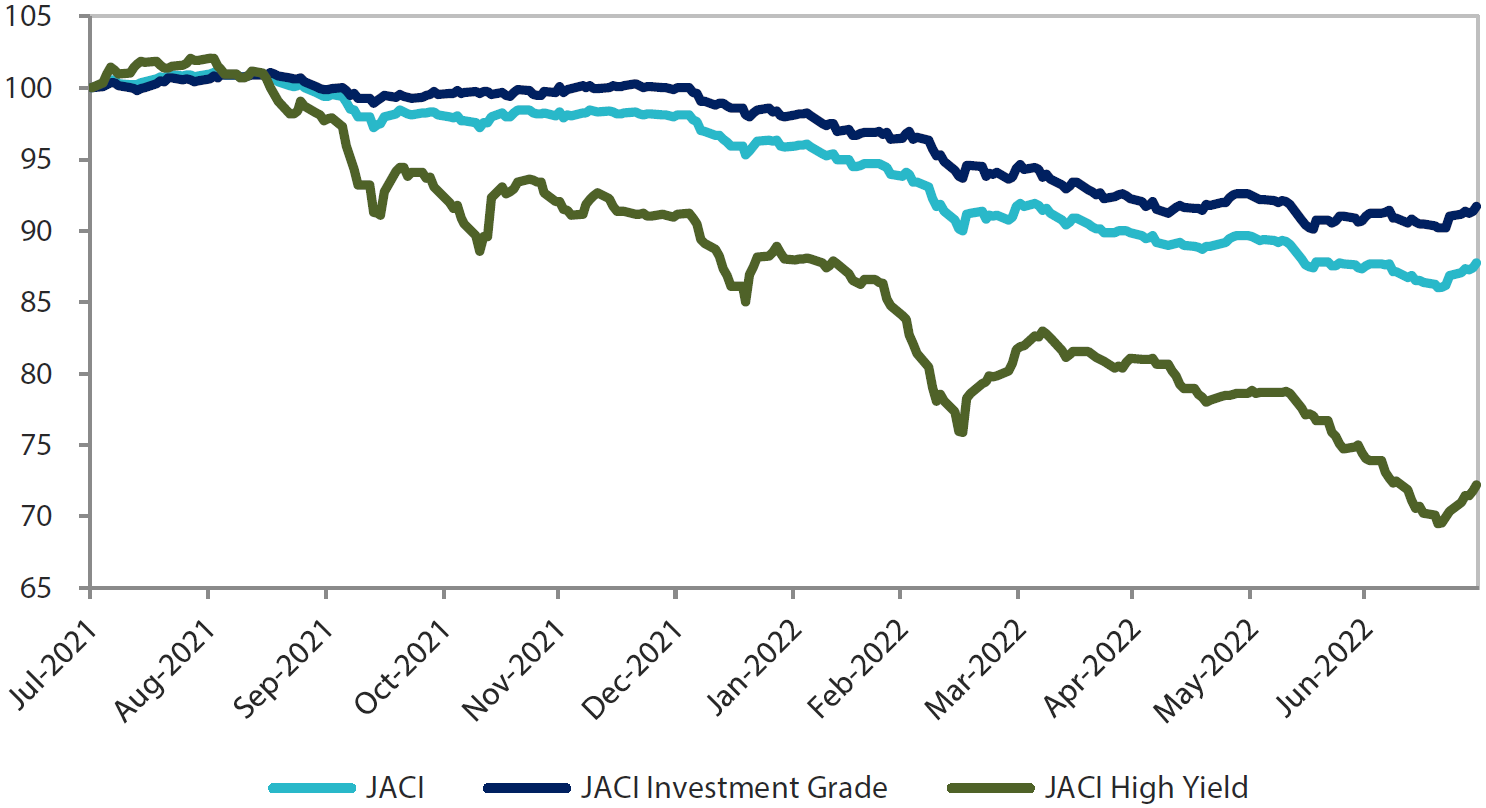Summary
- The US Treasury (UST) yield curve twist flattened in July; during the month, the Federal Reserve (Fed) raised interest rates by 75 basis points (bps). The European Central Bank (ECB) also delivered a larger-than-expected 50 bps rate hike mid-month. UST yields fell after subsequent comments by Fed Chair Jerome Powell and as US gross domestic product (GDP) data showed that the US economy had contracted. At the end of the month, the benchmark 2-year and 10-year UST yields were at 2.887% and 2.651%, respectively, 7.0 bps and 36.4 bps lower compared to end-June.
- Inflationary pressures rose further in June, prompted largely by higher food and energy price inflation. The Monetary Authority of Singapore (MAS) and Bangko Sentral ng Pilipinas’ (BSP) made unscheduled moves to tighten their monetary policies. The MAS also revised its core inflation forecast range upwards.
- Bank Negara Malaysia (BNM) raised its policy rate by 25 bps for a second straight meeting. Bank of Korea (BOK) increased its policy rate by 50 bps to 2.25%. Bank Indonesia (BI) announced measures to further normalise monetary policy by raising money market rates for select tenors, strengthening currency intervention to control imported inflation and selling government bonds.
- At end of July, Chinese policymakers announced their zero-COVID strategy stance, showing a clear intent to strike a balance between coronavirus control and economic growth. The markets interpreted this stance as an indication that China’s official 5.5% growth target for 2022 was not set in stone. Chinese top leaders also called for efforts to stabilise property markets and ensure the delivery of pre-sold homes.
- We are taking a more constructive view in duration overall, as we believe that the markets have largely priced in hawkish Fed expectations. Among the low-yielding countries, we prefer Singapore and Hong Kong, while we like Malaysia and India among the mid- to high-yielding countries. On currencies, we maintain our preference for the Singapore dollar (SGD).
- Asian credits gained 0.25% in total return, as gains in USTs offset the 35-bps widening in credit spreads. Asian credit spreads widened on inflation and growth concerns and worries about the Chinese property sector.
- Coupled with the uncertainty in the Chinese market, growth and corporate credit fundamentals across Asia are likely to moderate in the second half of the year but still remain robust enough to prevent a meaningful widening of credit spreads. Rising global slowdown fears is expected to limit the upside. A general improvement in fund flows into risky assets may be key factor that determines the direction of spreads.
Asian rates and FX
Market review
The UST yield curve flattens in July
The UST yield curve twist flattened in July, as bonds staged a sharp rally at the month-end. Hawkish surprises in both Federal Open Market Committee (FOMC) and ECB minutes for June prompted the initial move higher in UST yields. Fed officials emphasised the need to restore price stability even if it meant allowing a slowdown in the economy, while the ECB indicated it could raise rates by more than 25 bps at its July meeting. Investors re-priced more aggressive interest rate hikes by the Fed, putting upward pressure on front-end yields after data revealed continued strength in the US labour market amid persistent inflation. Simultaneously, concerns that sustained high inflation and increasingly aggressive central bank efforts to tame it would tip the US economy into recession kept a lid on longer-dated yields.
The ECB delivered a larger-than-expected 50 bps rate hike mid-month. In spite of the ECB’s tightening stance, UST yields turned lower following a string of soft domestic data which quickly led markets to recalibrate recession risks in the world’s largest economy. As the markets expected, the Fed raised the Fed Funds rate by 75 bps for the second consecutive month, demonstrating its resolve to curb inflation. Despite the sizable move, the market interpreted subsequent comments by Fed Chair Jerome Powell as an indication that the monetary tightening cycle was moderating, sparking a rally in both risk assets and bonds. UST yields fell further after US GDP data showed that the economy contracted for the second consecutive quarter. At the end of the period, the benchmark 2-year and 10-year UST yields were at 2.887% and 2.651%, respectively, 7.0 bps and 36.4 bps lower compared to end-June.
Chart 1: Markit iBoxx Asian Local Bond Index (ALBI)
| For the month ending 31 July 2022 | For one year ending 31 July 2022 | |

|

|
Source: Markit iBoxx Asian Local Currency Bond Indices, Bloomberg, 31 July 2022
Note: Bond returns refer to ALBI indices quoted in local currencies while FX refers to local currency movement against USD. ALBI regional index is in USD unhedged terms. Returns are based on historical prices. Past performance is not necessarily indicative of future performance.
Inflationary pressures rise further in June
Inflationary pressures rose further in June, prompted largely by higher food and energy price inflation. Headline consumer price index (CPI) inflation in the Philippines accelerated to 6.1% year-on-year (YoY)—the highest in more than three years—from 5.4% in May, as food and transport prices increased. Overall inflation in Singapore increased to 6.7% YoY from 5.6%, due largely to the significant rise in core inflation and the sharp increase in private road transport inflation. Thailand’s headline CPI increased to 7.66% YoY in June from 7.1% in May, driven mainly by the rise in energy price inflation, while a similar gauge in Malaysia picked up to 3.4% YoY, due in part to higher food inflation. In South Korea, overall inflation hit a 24-year high of 6.0% YoY in June from 5.4% in May, on the back of rising costs in oil, agricultural products, seafood and dining out.
MAS and BSP make unscheduled moves to tighten policy
In an inter-meeting move, the MAS announced a re-centering of the SGD nominal effective exchange rate (NEER). The move was accompanied by a revision in its core inflation forecast range to 3.0–4.0%, up from 2.5–3.5%. According to the monetary authority, core inflation will rise “slightly above 4% in the near term, before easing towards the end of the year”. Similarly, the BSP surprised markets with an aggressive 75 bps rate hike in an inter-meeting move. BSP Governor Felipe Medalla maintained a hawkish tone, saying that the central bank “will not rule out another hike in August”, although he added that “the need to do 50 (bps hike) in August is much, much less now”.
BNM and BOK hike rates, BI announces measures to further normalise monetary policy
Malaysia’s central bank raised its policy rate by 25 bps for the second straight meeting. BNM declared that monetary policy remains accommodative and supportive of growth, and that future adjustments to the policy rate will be “measured and gradual”. In South Korea, the BOK pushed up its policy rate by 50 bps to 2.25%. During the post-meeting press conference, Governor Rhee Chang-yong suggested that the central bank could further hike rates at each of its three remaining meetings in 2022, albeit at a more measured pace, “if inflation and growth trends do not change significantly”. Elsewhere, BI kept its 7-day reverse repo rate at 3.50%; at the same time, it also unveiled steps to accelerate the normalisation of monetary policy while holding its 7-day policy rate steady. Among other things, the central bank will raise money market rates for select tenors, strengthen currency intervention to control imported inflation and sell government bonds.
China’s Politburo commits to zero-COVID strategy, to “strive to achieve the best possible results”
At the month-end, China’s Politburo vowed to stand its ground on the zero-COVID strategy, showing a clear intent to strike a balance between coronavirus control and economic growth. Policymakers refrained from announcing huge stimulus measures and mentioned keeping growth within a “reasonable range”; the markets interpreted this stance as an indication that China’s official 5.5% growth target for 2022 was not set in stone. Nonetheless, top leaders also called for efforts to stabilise property markets and ensure the delivery of pre-sold homes.
Market outlook
Turning more constructive on duration overall
We believe markets have largely priced in hawkish Fed expectations. This, together with rising global growth concerns and data suggesting that inflation may soon peak, prompts us to take a more constructive view on duration overall. Among the low-yielding countries, our preference is Singapore and Hong Kong, while we like Malaysia and India among the mid- to high-yielding countries. We maintain that inflation will be better contained in Malaysia vis-à-vis other countries, while domestic inflation in India demonstrates early signs of easing.
On currencies, we maintain our preference for the SGD, on the view that outperformance of the currency is supported by expectations of further FX tightening by the MAS as core inflation in Singapore remains elevated.
Asian credits
Market review
Asian credit spreads widen on inflation and growth concerns, worries about the Chinese property sector
Asian credits gained 0.25% in total return, as gains in USTs offset the 35 bps widening in credit spreads. Asian high-grade (HG) returned +0.76% despite spreads rising 27 bps, as UST yields fell. Asian high-yield (HY) underperformed, declining 2.44% as spreads widened 103 bps on continued weakness in the Chinese property sector.
Asian credit spreads widened steadily in July. Weak risk sentiment was signalled initially by investor re-pricing of more rate hikes by the Fed on the back of surging inflation and continued strength in the US labour market. Subsequently, a string of weaker US economic data led the markets to recalibrate recession risks in the world’s largest economy.
China’s 2Q22 GDP growth moderated significantly to 0.4% YoY, largely missing expectations. This, coupled with fears of reversion to prohibitive measures as new COVID cases crept higher, further weighed on sentiment. With reports coming in that Chinese home buyers across the country were suspending their mortgage payments in response to delayed delivery of the pre-sold properties, Asian credit spreads—led by Chinese credits—pushed wider. Payment suspensions remained the focal point for investors for the rest of July, especially after certain suppliers to the real estate developers reportedly also deferred payments of their bank loans, citing unpaid bills owed. Subsequently, it was reported that policymakers are looking to set up a Renminbi (CNY) 300 billion real estate fund to restore investor confidence. At the month-end, China’s Politburo vowed to stand its ground on the zero-COVID strategy, showing a clear intent to strike a balance between coronavirus control and economic growth. Top leaders also called for efforts to stabilise property markets and ensure the delivery of pre-sold homes. This notwithstanding, the lack of concrete details, particularly around central government support, prompted markets to fixate on the negative effects of sustained stresses in the property sector onto the broader economy.
Outside of China, Asian credit spreads generally widened earlier in the month in line with broader risks markets. However, spreads subsequently recouped most of the tightening after the July FOMC meeting which sparked a further retreat of UST yields and easing of global financial conditions. Indonesian credits outperformed, tightening for the month, supported by the significant tightening in sovereign and quasi-sovereign spreads in the latter part of the month. However, spreads within the region, ex-Indonesia, still ended wider in July. For the frontier markets, S&P Global Ratings revised the outlook on Pakistan’s long-term ratings to “negative” from “stable”, citing “the increasing risk to the government's liquidity” as its “external position is weakening due to higher commodity prices, rupee depreciation, and tighter global financial conditions”. Elsewhere, Ranil Wickremesinghe was elected as Sri Lanka’s new president late in July. Still, domestic political uncertainty remains elevated in Sri Lanka, which may potentially jeopardise the rescue talks with the International Monetary Fund (IMF).
Primary market activity remains weak in July
Issuers stayed largely sidelined in the earlier half of the month, with primary market activity picking up in the latter half of July. The HG space saw 22 new issues amounting to about US dollar (USD) 8 billion, including the USD 1.25 billion two-tranche issue from Lenovo Group Ltd, USD 1.0 billion two-tranche issue from TSMC Global and USD 1.0 billion two-tranche issue from POSCO. Meanwhile, the HY space saw six new issues raise a total of USD 513 million.
Chart 2: JP Morgan Asia Credit Index (JACI)
Index rebased to 100 at 31 July 2021

Note: Returns in USD. Past performance is not necessarily indicative of future performance.
Source: Bloomberg, 31 July 2022
Market outlook
Mixed fundamentals, valuation and technical drivers across different segments of Asia credit market
Asian credit is facing mixed fundamentals, valuation and technical drivers across its different segments; furthermore, it remains to be seen whether the positive global risk sentiment that has prevailed after the July FOMC meeting can be sustained. China’s growth recovery remains unstable as evidenced by the weaker-than-expected July official purchasing managers' index (PMI) data. Private sector confidence, especially in the real estate sector, remains pressured by persistent COVID case numbers and resulting mobility restrictions. Meanwhile, the policy stance following China’s Politburo meeting, while still representing material easing that will support growth in the second half of the year, fell short of market expectations. These developments are expected to continue to pressure spreads in the China real estate sector, as well as lower-rated private-owned credits, although the extent of the widening which has already taken place could limit downside risks from here while policy catalysts are still needed for any meaningful tightening.
Elsewhere across Asia, growth and corporate credit fundamentals are likely to moderate in the second half of the year but still remain robust enough to prevent meaningful credit spread widening. However, rising global slowdown fears are expected to limit the upside, especially after the tightening seen in the second half of July. Improvement in fund flows into risky assets in general, and Emerging Market fixed income in particular, may play a strong role in determining the direction of spreads from here.



